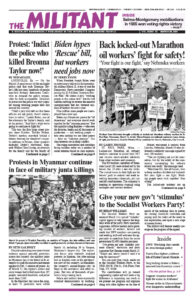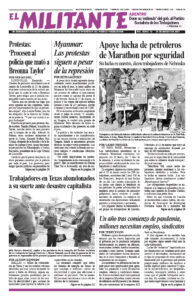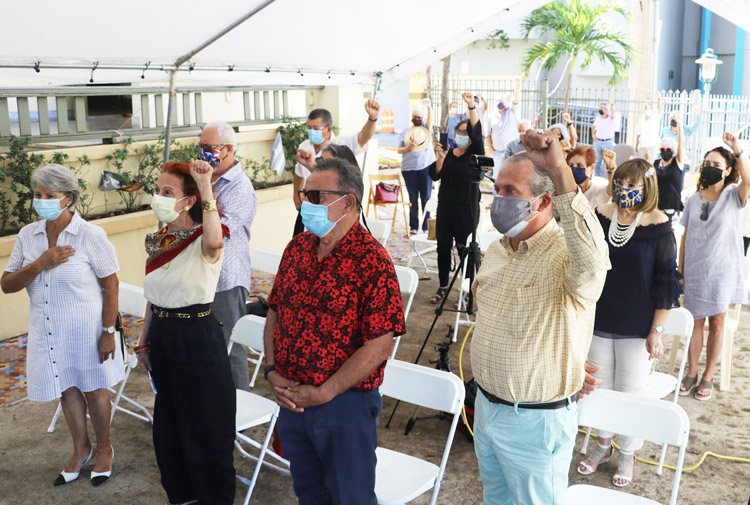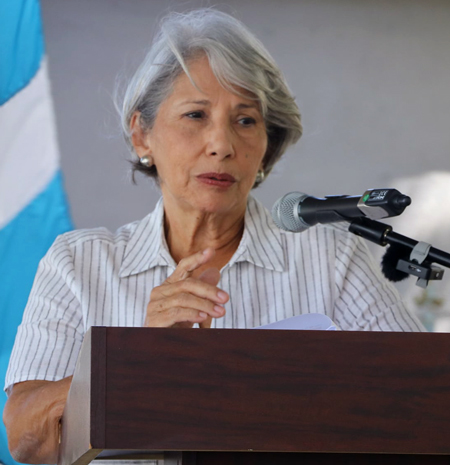Several events were held in Puerto Rico from Feb. 28 to March 7 to honor the life of revolutionary leader and independence fighter Rafael Cancel Miranda, who died March 2 last year.
They also marked the anniversary of the 1954 armed demonstration by Cancel Miranda and three other Puerto Rican independence fighters inside the U.S. Congress, organized to focus international attention on the struggle to free Puerto Rico from U.S. colonial rule.
The weeklong program began with a public event at the Casa Aboy cultural center in San Juan. It featured a talk by María de los Ángeles Vázquez, Cancel Miranda’s wife.
On March 1, 1954, Cancel Miranda — then 23 — joined Lolita Lebrón, Irvin Flores and Andrés Figueroa Cordero, all Puerto Rican Nationalist Party members, to unfurl a Puerto Rican flag inside the U.S. Capitol. They fired shots to draw attention to the brutal realities of U.S. colonial rule and the fact that Washington’s claim the island nation was “self-governing” was a lie. A few months earlier, the U.S. government had rammed through a resolution in the U.N. removing Puerto Rico from its official list of colonies, on the basis that it was now a “commonwealth.”
Our goal was “to tell the world that there were Puerto Ricans who were willing to die for our independence,” Cancel Miranda told the Militantin a 1998 interview.
Vázquez noted that Cancel Miranda had joined the liberation struggle at an early age and was first arrested in 1948 — at age 18 — and sentenced to two years in prison for defying the U.S. draft. He was sent to the federal prison in Tallahassee, Florida.
“To me it didn’t make sense to be in the same army that invades your country and massacres your people,” Cancel Miranda told the Militant. “If you’re going to fight, you should fight them.” While he was in prison, the U.S. war on the Korean people began and the colonial regime in Puerto Rico crushed an October 1950 revolt inspired by Nationalist Party leader Pedro Albizu Campos.
After completing his sentence, Cancel Miranda returned to Puerto Rico. But he was threatened with arrest again if he didn’t comply with the draft and he took refuge in Cuba. In March 1952 Fulgencio Batista staged a military coup and imposed a U.S.-backed dictatorship in Cuba. Cancel Miranda was deported to Puerto Rico. The FBI jailed him again, this time at the notorious La Princesa prison in San Juan.
Vázquez told the audience a little-known story about the revolutionary fighter. To get him out of jail “and make it possible for him to carry out a future action,” he and the Nationalist Party decided Cancel Miranda would give the impression he would comply with the draft. “Rafael was sent to Camp Buchanan [in San Juan]. There, during his brief stay, he took part in various incidents, and he told me that he had stirred up the draftees with his Nationalist speeches.”
Worried Cancel Miranda’s anti-colonial propaganda would fall on receptive ears in the midst of the Korean War, the military brass “declared him unfit for military service,” Vázquez said with a smile.
Political work in New York
By December 1952 Cancel Miranda was living in New York City, helping to organize the Nationalist Party in the Puerto Rican community. He worked two jobs, one in a factory in Brooklyn and one in Manhattan, working for two French brothers who owned Édouard Custom Shoes, which made shoes for Broadway actors.
In the days after the 1954 armed protest in Congress, the U.S. media attempted to paint the Nationalists as dangerous outlaws. But, Vázquez said, Mr. Édouard told the press “he didn’t know anything about Rafael’s political activity, but Rafael was a very decent person and when he got out of jail, if he wanted, he could come back to work at the store.”
Cancel Miranda and his three comrades spent a quarter century in U.S. prisons. As a result of a growing international campaign on their behalf, President James Carter finally released Figueroa Cordero in 1978 and Cancel Miranda, Lebrón and Flores a year later, along with another jailed Nationalist, Oscar Collazo.
Cancel Miranda spent the next four decades speaking out and joining actions for the freedom of Puerto Rico, in defense of Cuba’s socialist revolution and other struggles the world over.
The week of activity, sponsored by Casa Albizu Foundation and Cancel Miranda’s family, included the launching of the website sembrandopatria.com (Sowing the seeds of the homeland) to make accessible his writings, books and lifelong political record. Included on the site are 294 pages from the independence fighter’s extensive police files, going back to when he was 16 — a record he always wore as a badge of pride.
One of the events featured a talk by prominent independence advocate Eduardo Villanueva on the political background to the 1954 events.
In the western city of Mayagüez, where Cancel Miranda is buried, a graveside ceremony and memorial Mass were held in his honor.
One of the solidarity messages to the events’ sponsors was sent by the Socialist Workers Party. It quoted from a letter sent last year to Vázquez and her family by Jack Barnes, national secretary of the SWP: “We honor the life of comrade Rafael Cancel Miranda by continuing to educate working people, as well as the youth who join them in battle, about the road of revolutionary class struggle, the only road to a free Puerto Rico and a socialist world.”



